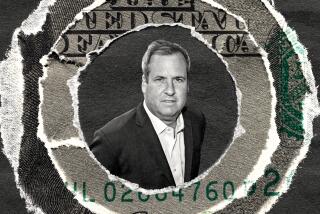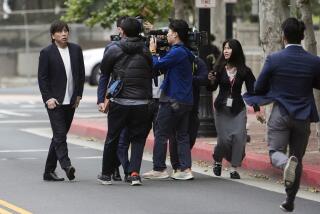Accounting in Levine Case : Court Filings Shed Light on an Inside Trader’s Finances
- Share via
NEW YORK — Insider trader Dennis B. Levine, who is serving a jail term for his part in the largest stock trading scandal ever exposed, claims to have gambled away $200,000 of his millions in illicit profits during 27 trips to the Bahamas, according to documents filed Tuesday in federal court here.
The court-appointed receiver of Levine’s assets said the assertion could not be verified through interviews with officials of the two casinos named by Levine. The casinos said there are no records that Levine had ever visited the establishments.
That makes the gambling loss the largest sum that remains unaccounted for after an extensive investigation of Levine’s assets by the receiver, New York attorney Sheldon I. Goldfarb.
No Evidence of Accumulation
The investigation was ordered by the federal court after Levine pleaded guilty to felony insider trading. Specifically, Goldfarb was ordered to determine how Levine spent $1.9 million in illicit profits he had withdrawn from a secret bank account.
In his report to the court, Goldfarb said he found no evidence that Levine had accumulated any cache of money or assets otherwise unknown to federal authorities or that he had any secret source of income between 1980 and 1986 other than the extensive insider trading he acknowledged last year to the Securities and Exchange Commission and federal prosecutors.
Goldfarb reported that, during the six-year period, Levine had $3.9 million in “spendable” income, including about $2 million in salary and bonuses and the $1.9 million in withdrawals that he made from his cache of illicit profits at the Bahamian branch of Bank Leu, a Swiss bank. His expenditures, including more than $500,000 deposited in U.S. bank accounts, came to $72,000 more than that, according to his own documentation and other claims.
Any larger discrepancy, Goldfarb said in an interview, “would have been a problem.”
“If his spending was significantly larger, that would indicate there was another income source,” he said. “If it was significantly lower, we’d wonder if he was hiding something. But the fact the numbers are so close gave us comfort that we had covered the ballpark.”
Still, information in Goldfarb’s report provides insights into the life style of Levine, who was a rising star of the investment banking world until May, 1986, when he was charged with having made $12 million in illegal profits through three years of trading on secret information about pending merger deals. Most of the money was still deposited at Bank Leu when Levine was exposed.
Between 1980 and his arrest, Levine spent some $450,000 in renovating his Park Avenue cooperative apartment, including $40,000 on cabinetry and $5,000 on marble work. He spent $35,000 on taxis and limousines, or more than $106 per week, including the expense of having his young son chauffeured to and from school every day.
He spent an average of more than $300 a week in restaurants, frequently more than $200 in cash per meal. And he paid $140,000 to $150,000 to one of his inside tipsters, former investment banker Ira Sokolow, who is himself serving a jail term for his role in the affair.
Levine in April began serving a two-year term in the federal penitentiary in Lewisburg, Pa., after having pleaded guilty to his illegal trades. The sentence was relatively mild--he could have received 20 years--in part because Levine’s testimony was instrumental in the government’s case against Ivan F. Boesky, the prominent stock speculator who in November paid $100 million in fines and penalties to settle government charges that he had traded extensively on confidential corporate information, some of it provided by Levine.
In his report, the receiver treated Levine’s claims of extensive gambling losses, run up during some of his 27 trips to the Bahamas to check on his secret account and make withdrawals, with some skepticism. Levine’s friends and acquaintances interviewed by Goldfarb said he was not known as a gambler and that on occasion he had described gambling as “a vice . . . to be avoided,” in the report’s words.
On the other hand, Levine’s brother, Robert, told Goldfarb that he saw Levine gambling on several Bahamian trips on which he went along; often, the report said, Dennis Levine would give his brother $500 to $1,000 to gamble himself.
DENNIS LEVINE’S SPENDING, 1980-MID 1986 Paintings, lithographs and sculptures $100,000
Park Ave co-op purchase (part) 225,000
Co-op renovations 450,000
Food (at home) 110,000
Restaurants 98,000
Clothing 143,000
Maids and baby-sittters 30,000
10 vacations 70,000
27 trips to Bahamas 266,500
(including $200,000 in unverified gambling losses)
Gifts to family members 35,000
Payments for inside information 150,000
More to Read
Sign up for Essential California
The most important California stories and recommendations in your inbox every morning.
You may occasionally receive promotional content from the Los Angeles Times.










